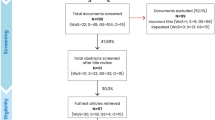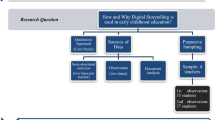Abstract
Japan is one of the disaster-prone countries. Then, various disaster education is conducted in schools and local communities for alleviating the damage caused by disasters. However, according to various surveys, disaster prevention awareness among young people is known to be lower than in other age groups in Japan. Therefore, we worked with Kanagawa Prefecture, Japan, on establishing an ICT-based program on disaster prevention and mitigation to raise awareness of disaster prevention and mitigation among young people. The program is based on the workshop consisting of town watching and group discussion using DITS/DIMS (disaster information tweeting and mapping system) proposed in the previous studies. In this paper, we introduce the contents of the established education program on disaster prevention and mitigation for the young generation. Moreover, we report on the results of the workshops for disaster prevention and mitigation using this program at several junior high and high schools in Kanagawa Prefecture, Japan. The results of the post-questionnaire show that many participants had a positive impression on the developed disaster education program.










Similar content being viewed by others
References
Cabinet Office, Government of Japan. (2015). Disaster Management in Japan. http://www.bousai.go.jp/1info/pdf/saigaipamphlet_je.pdf. Accessed 19 Apr 2020.
Gelernter, J., & Balaji, S. (2013). An algorithm for local geoparshing of microtext. GeoInformatica, 17(4), 635–667.
Imran, M., Castillo, C., Diaz, F., & Vieweg, S. (2015). Processing social media messages in mass emergency: A survey. ACM Computing Surveys, 47(4), 67.
Katada, T., & Kanai, M. (2016). The school education to improve the disaster response capacity: A case of “Kamaishi Miracle". Journal of Disaster Research, 11(5), 845–856.
Kodama, S. (2015). Tsunami-tendenko and morality in disasters. Journal of Medical Ethics, 41(5), 361–363.
Komura, T., & Hirano, A. (1997). On Disaster Imagination Game, Proc. of Institute of Social Safety Science (pp. 136–139). (in Japanese).
Kosugi, M., Utsu, K., Tajima, S., Tomita, M., Kajita, Y., Yamamoto, Y., & Uchida, O. (2017). Improvement of Twitter-based Disaster-related Information Sharing System. Proc. 4th International Conference on Information and Communication Technologies for Disaster Management.
Moriwaki, T., Shigene, M., & Yamamoto, T. (2019). Development of ART program using Nigechizu in scenario of tsunami hazard and its evaluation. AIJ Journal of Technology and Design, 25(59), 361–365. (in Japanese).
Nagamatsu, S., & Hayashi, H. (2012). Economic recovery scenario planning for a Tokyo inland earthquake. Journal of Disaster Research, 7(2), 203–214.
National Geospatial-Intelligence Agency (2009) Military map reading 201. http://earth-info.nga.mil/GandG/coordsys/mmr201.pdf. Accessed 19 Apr 2020.
Nigechizu Manual (educational version). (2016). http://edu.nigechizu.com/. Accessed 19 Apr 2020.
Nishikawa, S., Uchida, O., & Utsu, K. (2019). Analysis of rescue request tweets in 2018 Japan floods. Proc. 2019 International Conference on Information Technology and Computer Communications.
Peary, B. D. M., Shaw, R., & Takeuchi, Y. (2012). Utilization of social media in the East Japan earthquake and tsunami and its effectiveness. Journal of Natural Disaster Science, 34(1), 3–18.
Public Relations Office, Government of Japan. (2013). The miracle of Kamaishi. https://mnj.gov-online.go.jp/kamaishi.html. Accessed 19 Apr 2020.
Shibutani, T. (2020). General research group for the Nankai trough great earthquake. Journal of Disaster Research, 15(2), 165–173.
Shiwaku, K., Sakurai, A., & Shaw, R. (Eds.). (2016). Disaster Resilience of Education Systems. Tokyo: Springer Japan.
Simon, T., Goldberg, A., & Adini, B. (2015). Socializing in emergencies - A review of the use of social media in emergency situations. International Journal of Information Management, 35(5), 609–619.
Sugiyama, T., & Yamori, K. (2019). Development and social implementation of the “Nige-Tore” smartphone app for improving tsunami evacuation drills: Synergistic interactions between “Commitment” and “Contingency.” The Japanese Journal of Experimental Social Psychology, 58(2), 135–146. ((in Japanese)).
Sun, Y., Yamori, K., Suzuki, S., Lee, F., Sugiyama, T., Chijiwa, S., et al. (2017). Can smartphone apps motivate tsunami evacuation? IPSJ Journal, 58(1), 205–214. ((in Japanese)).
Suppasri, A., Shuto, N., Imamura, F., Koshimura, S., Mas, E., & Yalciner, A. C. (2012). Lessons learned from the 2011 great East Japan tsunami: Performance of tsunami countermeasures, coastal buildings, and tsunami evacuation in Japan. Pure and Applied Geophysics, 170, 993–1018.
Toriumi, F., Sasaki, T., Shinoda, K., Kazama, K., Kurihara, S., & Noda, I. (2013). Information sharing on twitter during the 2011 catastrophic earthquake. Proc. 22nd International Conference on World Wide Web Companion (pp. 1025–1028).
Twitter. (2012). https://twitter.com/Twitter/status/264408082958934016. Accessed 19 Apr 2020.
Uchida, O., Rokuse, T., Tomita, M., Kajita, Y., Yamamoto, Y., Toriumi, F., et al. (2015). Classification and mapping of disaster relevant tweets for providing useful information for victims during disasters. IIEEJ Transactions on Image Electronics and Visual Computing, 3(2), 224–232.
Uchida, O., Kosugi, M., Endo, G., Funayama, T., Utsu, K., Tajima, S., et al. (2016). A real-time information sharing system to support self-, mutual-, and public-help in the aftermath of a disaster utilizing twitter. IEICE Transactions on Fundamentals, E99-A(8), 1551–1554.
Wilensky, H. (2014). Twitter as a navigator for stranded commuters during the great east Japan earthquake. Proc, of the 11th International Conference on Information Systems for Crisis Response and Management (pp. 695–704).
Yamada, S., Utsu, K., & Uchida, O. (2018). An Analysis of Tweets During the 2018 Osaka North Earthquake in Japan - A Brief Report. Proc. 5th International Conference on Information and Communication Technologies for Disaster Management.
Yamori, K. (2007). Disaster risk sense in japan and gaming approach to risk communication. International Journal of Mass Emergencies and Disasters, 25(2), 101–131.
Yanagawa, Y., Takeuchi, I., Jitsuiki, K., Yoshizawa, T., Ishikawa, K., Omori, K., et al. (2016). Disaster imagination game at Izunokuni City for preparedness for a huge Nankai trough earthquake. Scholars Journal of Applied Medical Sciences, 4(6D), 2129–2132.
Author information
Authors and Affiliations
Corresponding author
Additional information
Publisher’s Note
Springer Nature remains neutral with regard to jurisdictional claims in published maps and institutional affiliations.
The manuscript is a revised and expanded version of the paper entitled “Workshop Program on Disaster Prevention and Mitigation for Young Generation Utilizing Disaster Information Tweeting and Mapping System” presented at the 4th IFIP Conference on Information Technology in Disaster Risk Reduction, Ukraine, Oct. 2019.
Rights and permissions
About this article
Cite this article
Uchida, O., Tajima, S., Kajita, Y. et al. Development and Implementation of an ICT-based Disaster Prevention and Mitigation Education Program for the Young Generation. Inf Syst Front 23, 1115–1125 (2021). https://doi.org/10.1007/s10796-020-10082-9
Accepted:
Published:
Issue Date:
DOI: https://doi.org/10.1007/s10796-020-10082-9




